As we age, our bodies change, but yoga can help keep us feeling young! Yoga does more than just stretch your muscles; it’s a great way to keep your mind and body fresh and lively. In this blog, we’ll explore some fantastic Yoga Poses for Anti-Aging. Whether you’re new to yoga or you’ve been doing it for years, these poses can help you feel more youthful. Keep reading to find out how yoga can help you stay young and vibrant!
Benefits of Yoga for Anti-Aging
Yoga is a treasure chest of health benefits, especially when it comes to keeping us looking and feeling young. For more information, read this. Here’s how it helps:
- Keeps Your Skin Glowing: Yoga increases blood circulation, which means more oxygen and nutrients are delivered to your skin. This process helps to flush out toxins and gives your skin a healthy, natural glow.
- Reduces Stress: According to research, Stress can make us age faster, but yoga is known for its ability to reduce stress. Through breathing exercises and meditation, yoga helps calm the mind, reducing stress and its aging effects on our bodies. Explore additional facial exercises to look younger, which also help in reducing stress
- Improves Flexibility and Balance: As we age, our joints and muscles can become stiff and our balance might worsen. Yoga poses work by stretching and strengthening these parts of our bodies, helping us maintain flexibility and balance, which can keep us agile as we grow older.
- Enhances Sleep: A good night’s sleep is crucial for repairing the body and maintaining youthful energy. Yoga can improve your sleep quality, making sure your body gets the rest it needs to recover and stay young.
Incorporating yoga into your life can not only help you look younger but feel younger too, by boosting your overall health and well-being. Learn more about specific facial yoga exercises for anti-aging that complement these yoga poses
1. Tadasana (Mountain Pose):
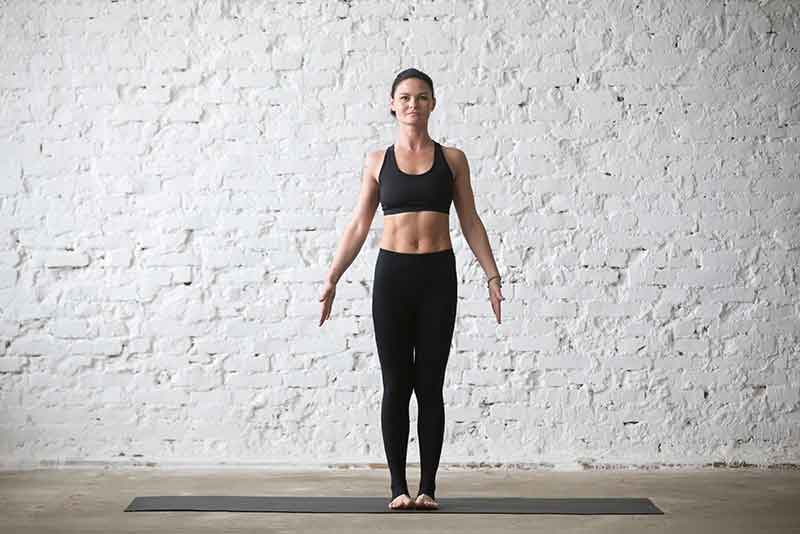
Tadasana, or Mountain Pose, is a simple yet powerful foundational yoga pose. It involves standing straight with feet together, arms at the sides, and the body evenly aligned. The pose encourages a feeling of grounding and stability through the feet, which spreads upwards through the entire body. As you engage your core, and thighs, and lift through the chest, Tadasana helps cultivate balance and strength.
See Tadasana demonstrated in our video to get the posture right.
Benefits: This pose is essential for improving posture, which is vital as we age. Good posture helps prevent back and neck pain and keeps your spine aligned and strong. Additionally, practicing Tadasana can also help reduce flat feet and strengthen the muscles in your thighs and feet.
2. Vrikshasana (Tree Pose):

Vrikshasana, or Tree Pose, mimics the steady, rooted stance of a tree. You begin in Tadasana, shift your weight onto one leg, and place the sole of the other foot on the inner thigh, calf, or ankle of the standing leg (avoiding the knee). The hands can be positioned in a prayer pose at the heart center or raised above the head. This poses challenges and improves your balance, and focuses on building strength in the standing leg and core.
Benefits: Tree Pose is excellent for enhancing balance and stability in the legs, which can diminish with age. It strengthens the thighs, calves, ankles, and spine while stretching the groin and inner thighs. This pose also helps improve neuromuscular coordination, aids in concentration, and offers a meditative focus that can calm the mind.
3. Bhujangasana (Cobra Pose):
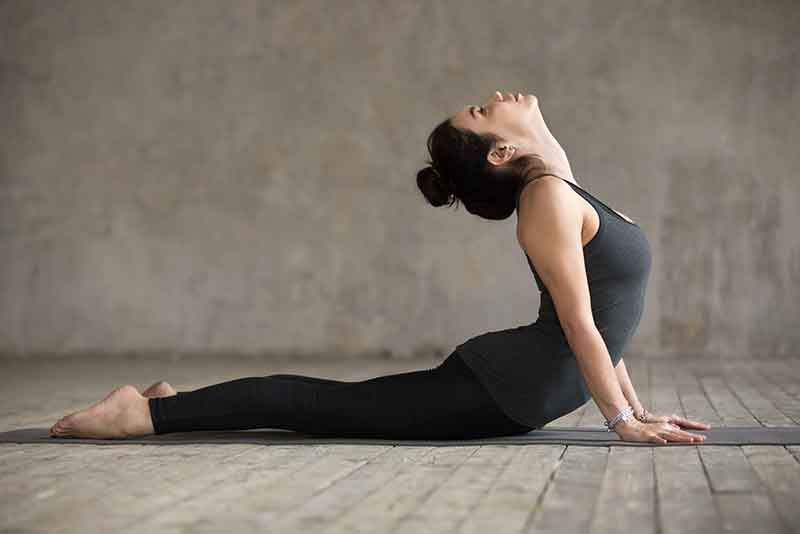
Bhujangasana, or Cobra Pose, is performed by lying on your stomach with your legs extended back and placing your hands on the floor under your shoulders. As you inhale, you press your hands into the ground and lift your chest, arching your back and keeping your elbows slightly bent. This pose stretches and strengthens the spine, opens the chest, and encourages flexibility in the middle and upper back.
Benefits: Cobra Pose is particularly beneficial for spinal health, crucial as we age to maintain flexibility and prevent the stiffness that can come with aging. It strengthens the spine, shoulders, and buttocks, and helps to open the lungs, which is beneficial for deeper breathing. Additionally, this pose stimulates abdominal organs, potentially improving digestion and helping to relieve stress and fatigue by invigorating the heart and lungs.
4. Balasana (Child’s Pose):
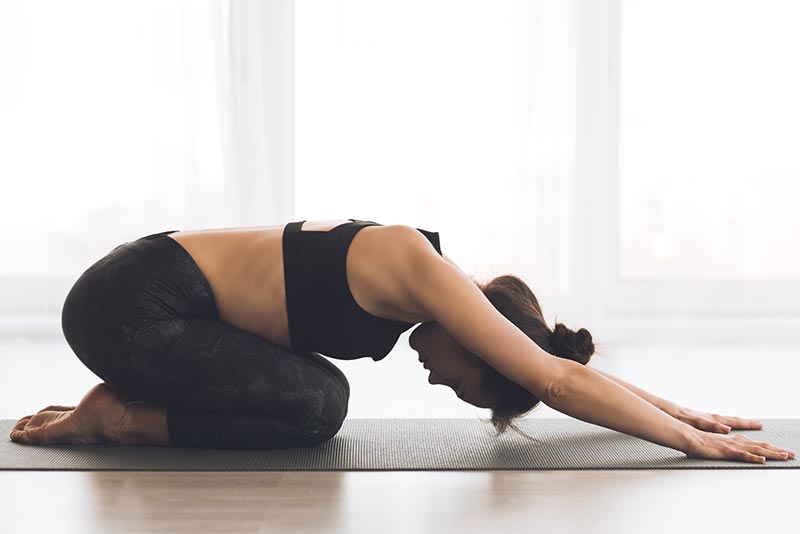
Balasana, or Child’s Pose, is a restful pose that can help release tension in the back, neck, and shoulders. This pose involves sitting on your heels with your knees either together or spread wide, then bending forward to rest your forehead on the floor, arms extended in front or alongside your body.
Benefits: Child’s Pose helps to calm the mind and relieve stress, which is crucial for anti-aging. It gently stretches the hips, thighs, and ankles, and can help alleviate back and neck pain when done with the head and torso supported.
5. Setu Bandhasana (Bridge Pose):
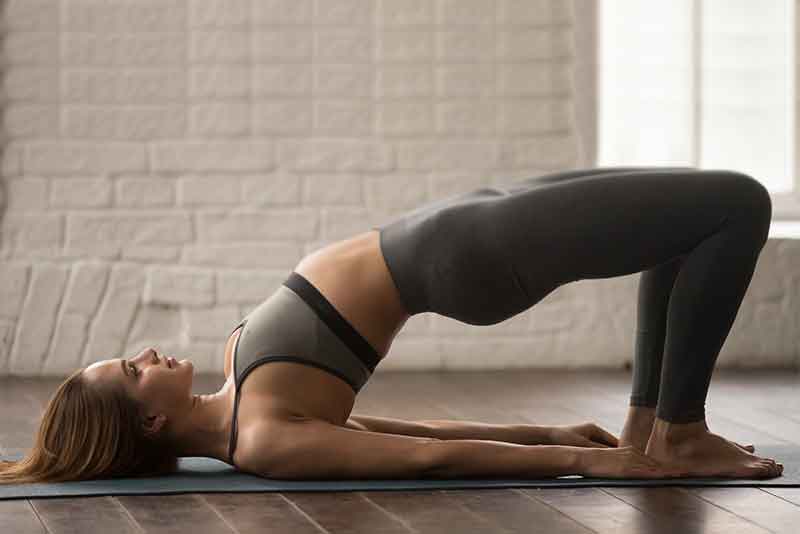
Setu Bandhasana, or Bridge Pose, is performed by lying on your back, bending your knees, and placing your feet flat on the floor hip-width apart. Press your feet and arms into the floor and lift your hips toward the ceiling, clenching your buttocks and engaging your core.
Benefits: This pose strengthens the lower back, glutes, and hamstrings, and can also improve spinal flexibility. Additionally, it opens up the chest and helps improve digestion, which can slow down due to aging.
6. Trikonasana (Triangle Pose):
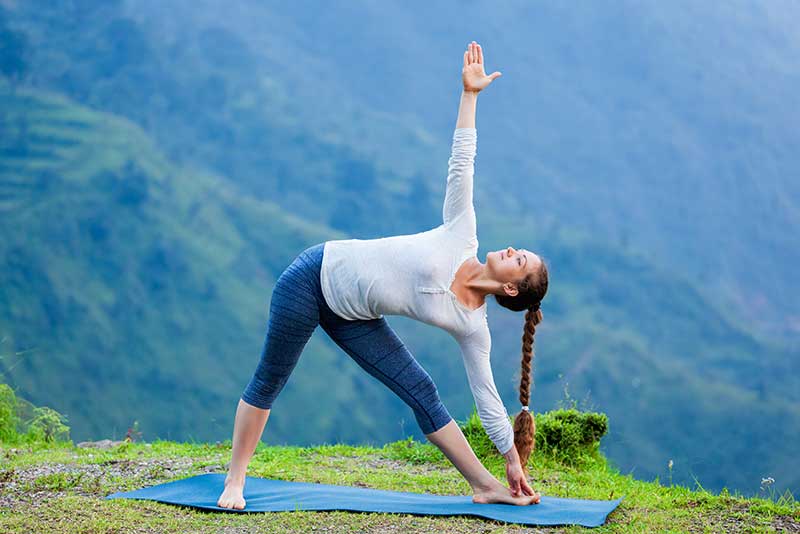
Trikonasana, or Triangle Pose, involves standing with your feet wide apart, extending your arms to the sides, and bending over your right leg to place your right hand on your ankle, shin, or the floor while extending your left arm toward the ceiling. Look up at your left hand if it’s comfortable for your neck.
Benefits: Triangle Pose stretches and strengthens the thighs, knees, and ankles, while also stretching the hips, groin, hamstrings, and calves, along with the shoulders, chest, and spine. It is especially good for improving balance and concentration.
7. Paschimottanasana (Seated Forward Bend):
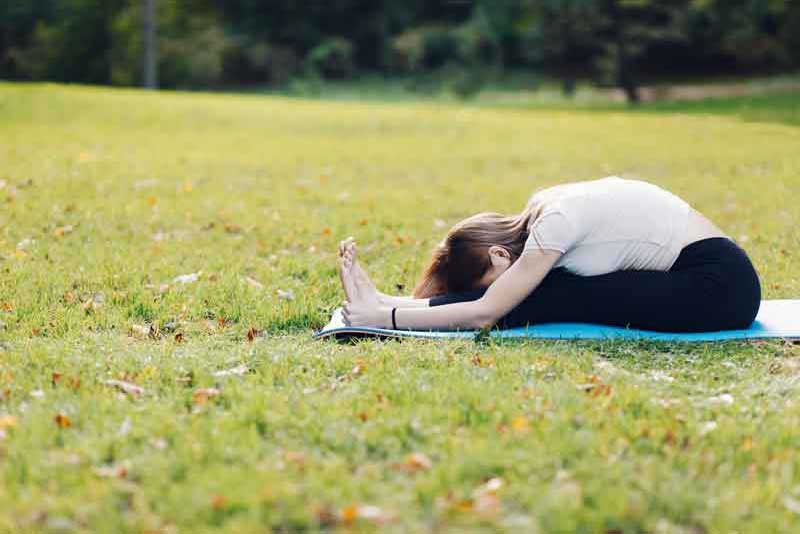
Paschimottanasana, or Seated Forward Bend, starts with sitting on the floor with legs extended straight in front. Inhale and raise your arms above your head, then exhale and reach forward to grab your feet, ankles, or legs, keeping your spine straight.
Benefits: This pose helps calm the brain, relieve stress, and reduce fatigue, which are all beneficial for anti-aging. It stretches the spine, shoulders, and hamstrings, and can help improve digestion.
8. Ardha Matsyendrasana (Half Lord of the Fishes Pose):
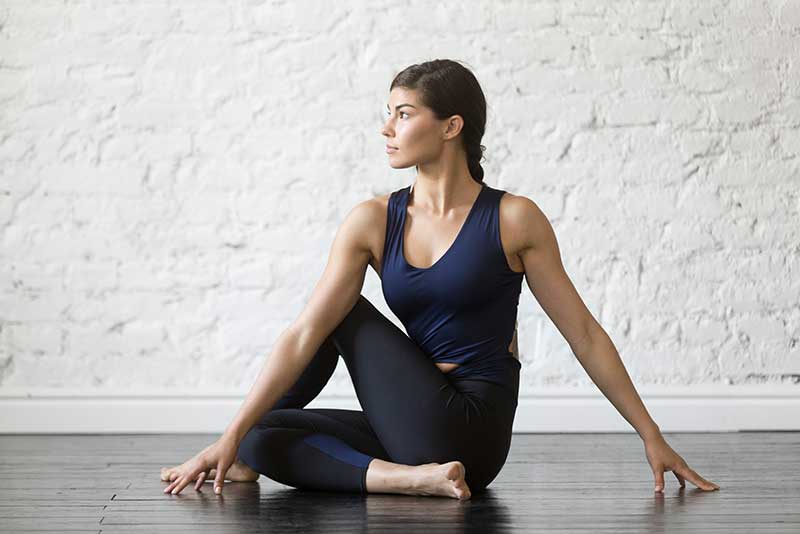
Ardha Matsyendrasana, or Half Lord of the Fishes Pose, is a seated spinal twist. Sit on the floor with your legs extended. Cross your right foot over the outside of your left thigh, and bend your left knee. Place your right hand on the floor behind you and your left elbow on the outside of your right knee to help you twist.
Benefits: This pose increases spinal flexibility and stretches the shoulders, hips, and neck. The twisting motion helps stimulate the digestive system, which is vital for cleansing and detoxifying the body, key aspects of anti-aging.
9. Adho Mukha Svanasana (Downward-Facing Dog):
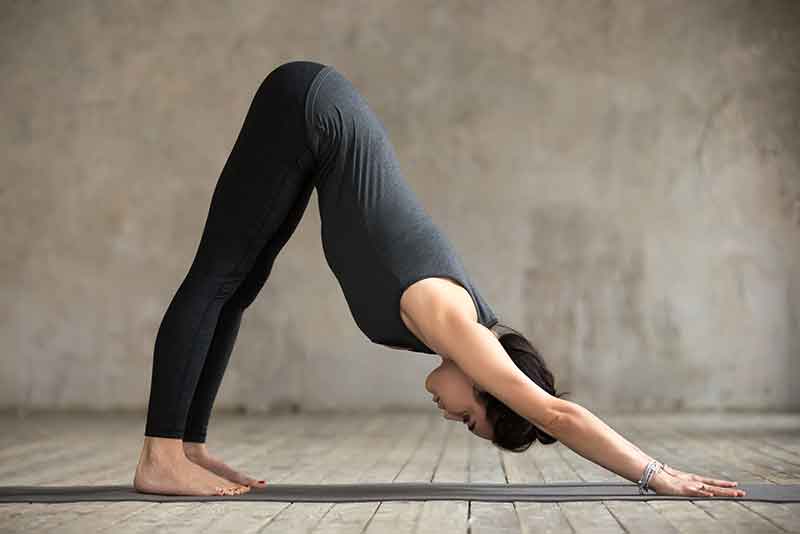
Adho Mukha Svanasana, commonly known as Downward-Facing Dog, involves forming an inverted V-shape with your body. From a tabletop position, lift your hips upwards and back, straightening your legs and arms, and pressing your heels towards the floor as your head hangs freely.
Benefits: This pose rejuvenates the entire body by stretching the hamstrings, calves, and spine while strengthening the arms, shoulders, and legs. It also improves blood circulation to the brain, which can enhance mental clarity and energy, both important for combating signs of aging.
10. Virabhadrasana II (Warrior II):
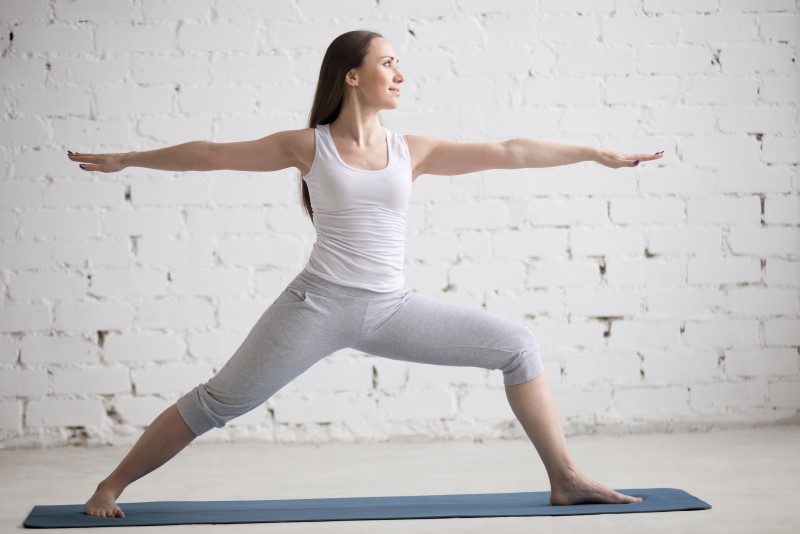
Virabhadrasana II, or Warrior II, is a standing pose that involves spreading your legs wide, extending one leg forward with a bent knee, and the other leg back with a straight knee, arms stretched out in opposite directions, and gazing over your forward hand.
Benefits: Warrior II increases stamina and endurance in your legs and core muscles, enhances balance and stability, and improves circulation and respiration. It also stimulates the abdominal organs, aiding in better digestion and metabolism.
11. Utkatasana (Chair Pose):
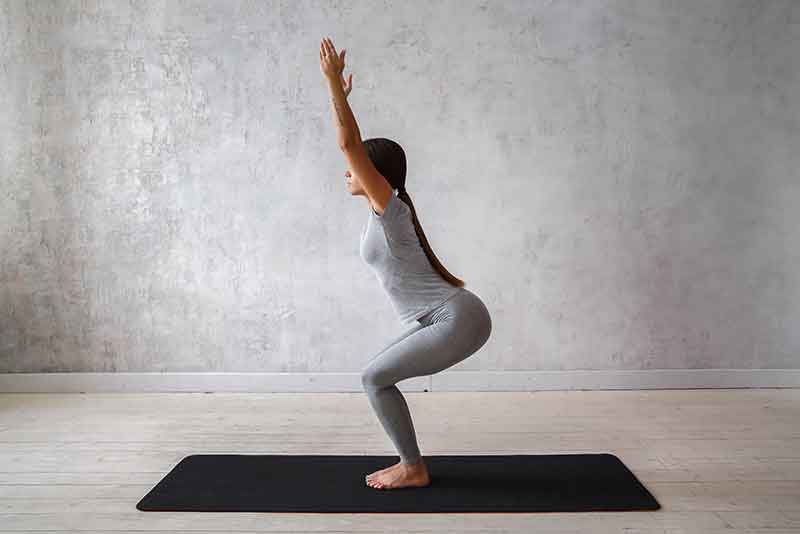
Utkatasana, or Chair Pose, involves standing with your feet slightly apart, stretching your arms forward, and bending your knees as if sitting in a chair, while keeping your back straight. This poses challenges to your balance, strength, and stability.
Benefits: Chair Pose strengthens the thighs and ankles, while toning the shoulders, butt, hips, and back. It also stimulates the heart and diaphragm, and stretches the chest and shoulders, helping to reduce the physical effects of aging.
12. Janu Sirsasana (Head-to-Knee Forward Bend):
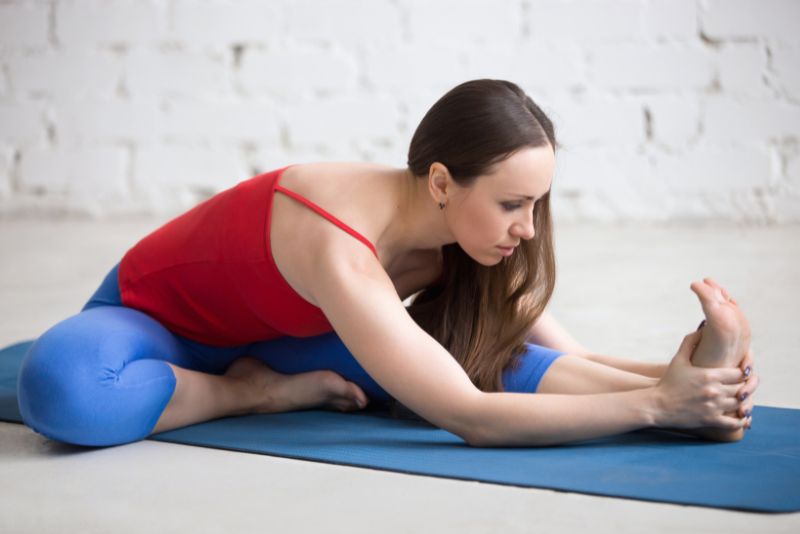
Janu Sirsasana, or Head-to-Knee Forward Bend, is performed by sitting on the floor with one leg extended and the other bent so that the heel is close to the pelvis, and then bending forward over the extended leg to grasp the foot, if accessible.
Benefits: This pose calms the mind and helps relieve mild depression and anxiety, important for maintaining mental health as you age. It stretches the spine, hamstrings, and groin, and improves digestion by stimulating the liver and kidneys.
13. Ananda Balasana (Happy Baby Pose):
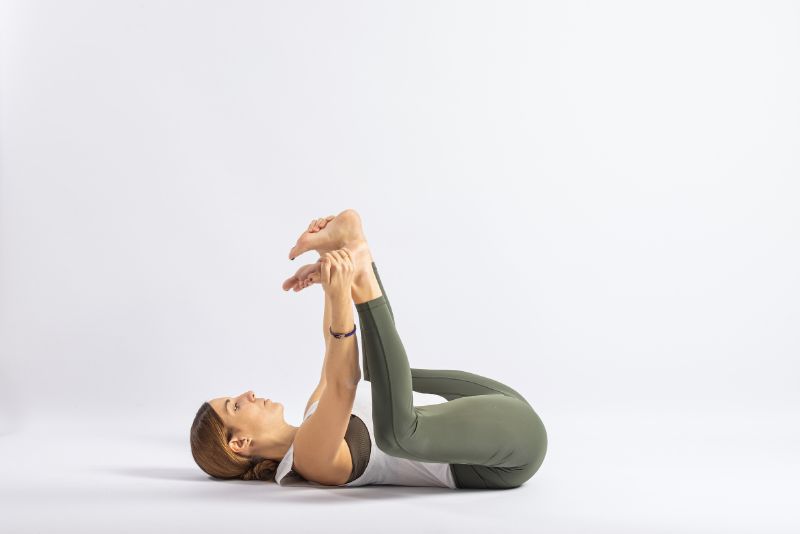
Ananda Balasana, or Happy Baby Pose, involves lying on your back, grabbing the outside edges of your feet with your hands, and pulling your knees towards your armpits, keeping your ankles directly over your knees so your shins are perpendicular to the floor.
Benefits: This playful pose helps release tension in the back and soothes the nervous system, promoting relaxation and reducing stress. It also stretches the hips, thighs, and hamstrings, which can help maintain mobility and flexibility.
14. Parivrtta Sukhasana (Seated Twist):
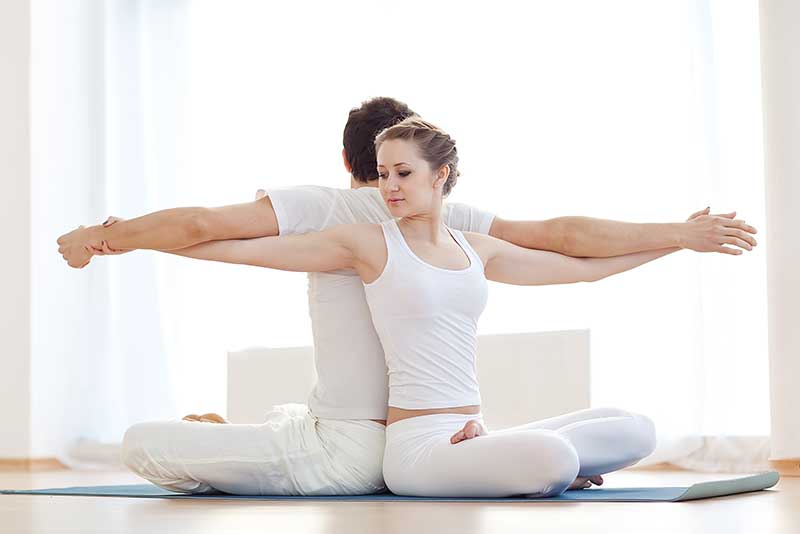
Parivrtta Sukhasana, or Seated Twist, is a gentle twisting pose performed while seated in a comfortable, cross-legged position. Place one hand on your opposite knee and the other behind you for support, and gently twist your torso and head to look over your shoulder.
Benefits: This pose helps maintain spinal flexibility, which can decrease with age. The twisting motion stimulates the digestive organs, aiding in detoxification and metabolism. It also helps relieve tension in the back, shoulders, and neck.
15. Prasarita Padottanasana (Wide-Legged Forward Bend):
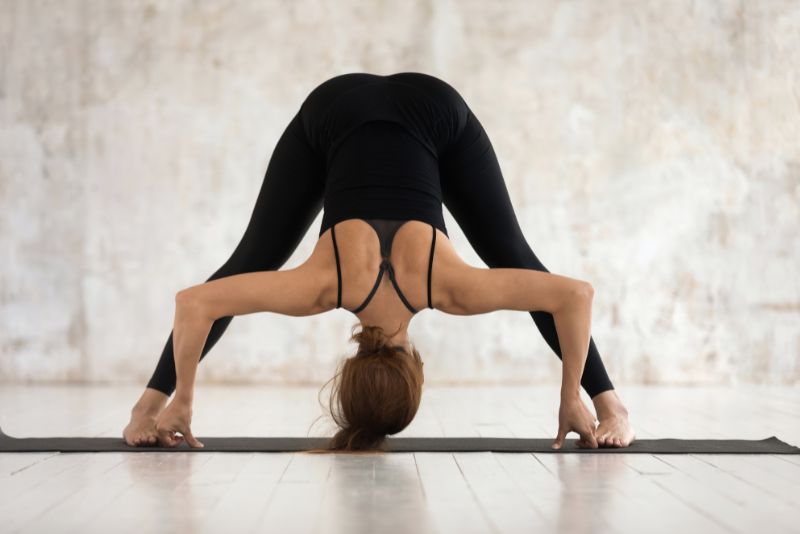
In Prasarita Padottanasana, or Wide-Legged Forward Bend, stand with your feet wide apart, hands on your hips, inhale, and as you exhale, bend forward from the hips, placing your hands on the floor beneath your shoulders. Relax your head toward the ground.
Benefits: This pose stretches the back and insides of the legs and the spine, promoting flexibility. It also invigorates the circulatory system by increasing blood flow to the brain, helping to alleviate fatigue and calm the mind.
16. Viparita Karani (Legs-Up-the-Wall Pose):
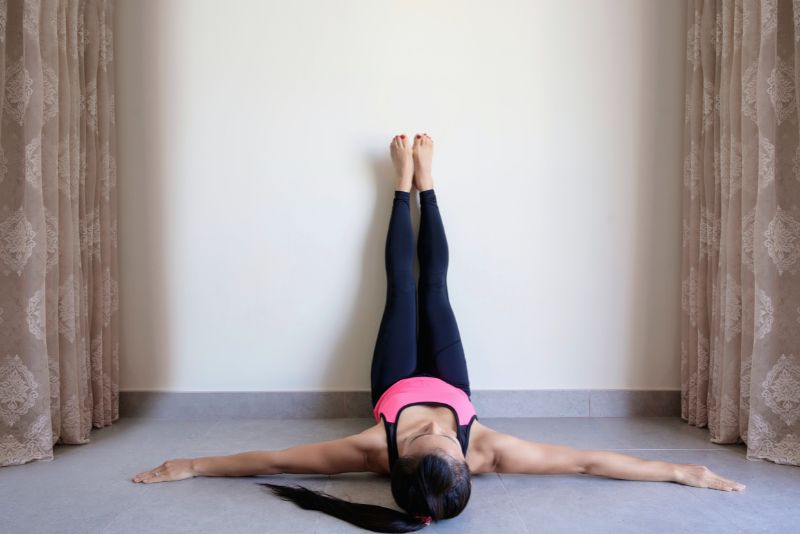
For Viparita Karani, lie on your back and extend your legs up against a wall. Your body should form a right angle with your legs straight up and your back flat on the floor. You can place a pillow under your hips for extra support.
Benefits: This restorative pose helps to relax the body and mind. It is excellent for relieving lower back pain and swelling in the legs and feet, common as we age. This pose also helps calm the nervous system, reducing anxiety and promoting better sleep.
17. Baddha Konasana (Bound Angle Pose):
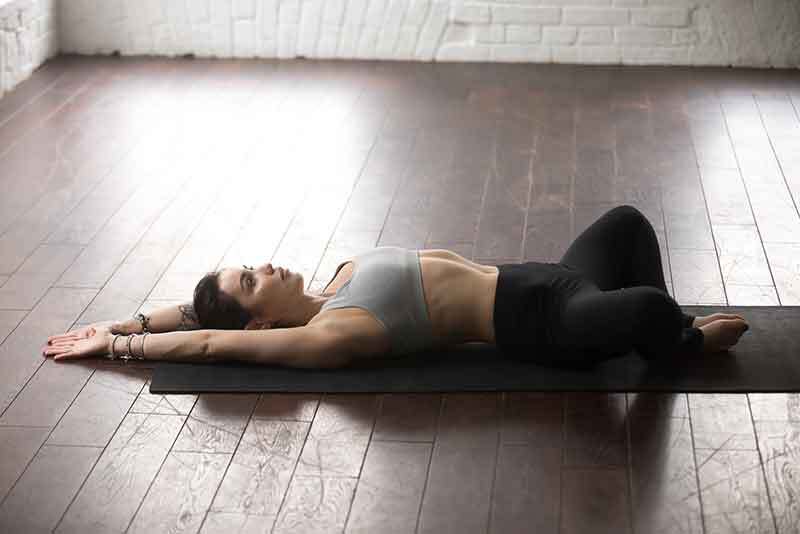
In Baddha Konasana or Bound Angle Pose, sit with your feet together and knees splayed out to the sides, pulling your heels toward your pelvis. Grasp your feet with your hands and gently press your knees towards the floor.
Benefits: This pose helps open the hips and groin, which can stiffen with age. It improves flexibility in the hips and knees and stimulates the abdominal organs, aiding in digestion and bladder function.
18. Matsyasana (Fish Pose):
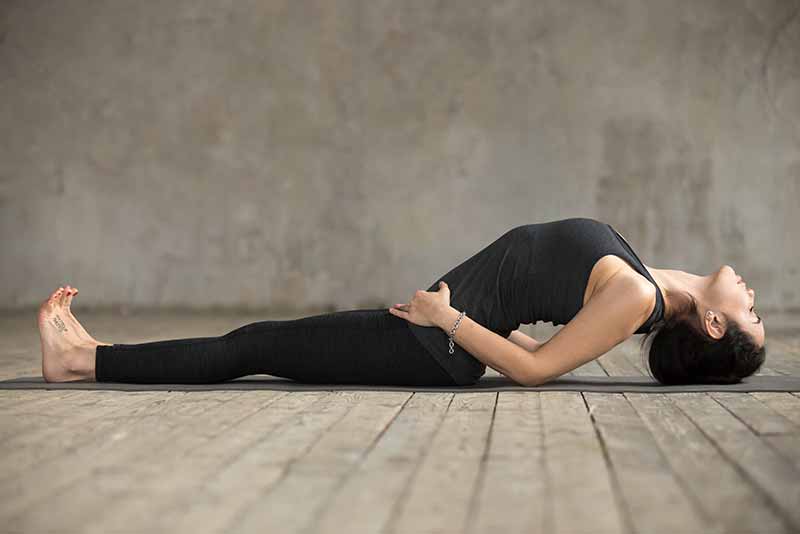
Matsyasana, or Fish Pose, is performed by lying on your back, placing your hands under your hips, and arching your chest upward while lifting your head and shoulders off the floor. Let your head gently tilt backward.
Benefits: Fish Pose is beneficial for the health of the thyroid, parathyroid, and pineal glands, which regulate aging-related hormones. It stretches the chest and neck, improving respiratory functions.
19. Savasana (Corpse Pose):
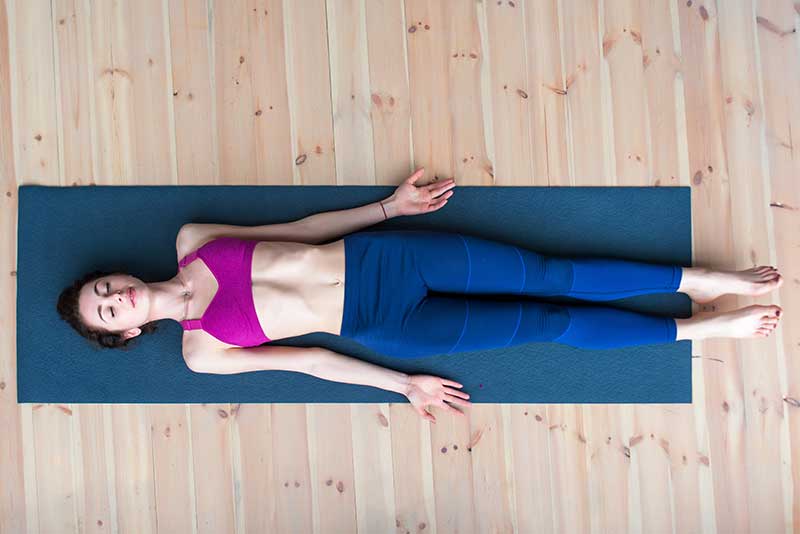
Savasana, or Corpse Pose, involves lying flat on your back with your arms at your sides and your eyes closed, allowing your body to sink into the ground. This pose is typically used for relaxation at the end of a yoga session.
Benefits: Savasana helps integrate all the benefits of the previous poses by allowing the body to fully relax and rejuvenate. It reduces stress, lowers blood pressure, and improves overall mental health, which are vital for combating the effects of aging.
20. Ustrasana (Camel Pose):
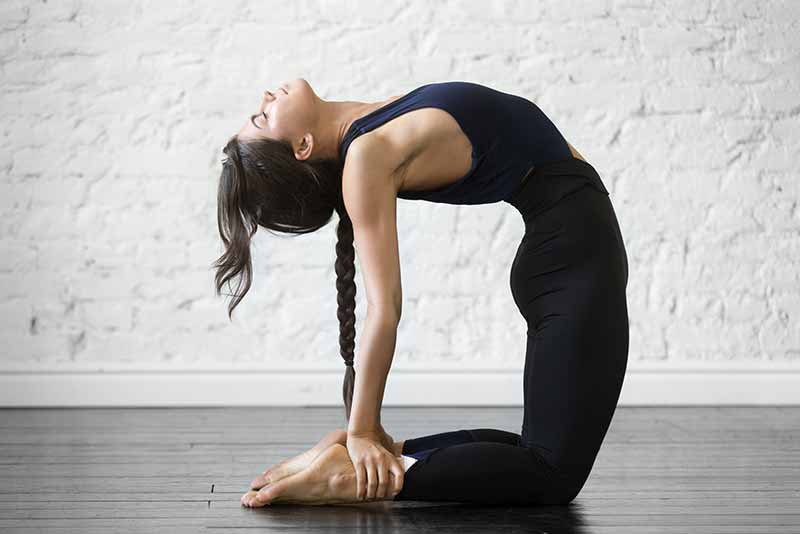
Ustrasana, or Camel Pose, is an invigorating backbend that stretches the entire front of the body while strengthening the back and shoulders. To perform this pose, kneel on the floor with your knees hip-width apart and your hands on your lower back for support. Gradually arch back and reach for your heels with your hands while pushing your hips forward and keeping your thighs perpendicular to the floor. If you can’t reach your heels, you can use blocks beside each foot for support.
Benefits: Camel Pose opens up the chest and lungs, improving breathing and aiding in better oxygenation of the blood. It also stimulates the abdominal organs, enhancing digestion and elimination, which are crucial for detoxification and overall health. The pose helps increase spinal flexibility, which can reduce stiffness and improve posture, all important factors in maintaining a youthful appearance and vitality.
21. Garudasana (Eagle Pose):
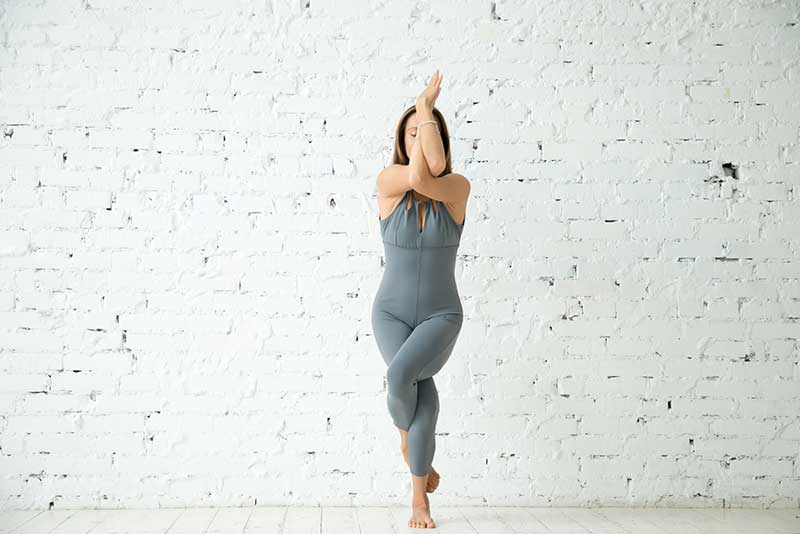
Garudasana, or Eagle Pose, involves standing and crossing one thigh over the other while balancing on one foot, with the opposite arm crossed under the other in front at the elbows and wrists. The palms come together if possible, and you squat slightly as you balance. The gaze should be fixed forward to help maintain balance.
Benefits: Eagle Pose is excellent for improving balance, focus, and concentration. It strengthens the calves, ankles, thighs, and hips while also stretching the shoulders and improving flexibility in the upper back. This pose enhances circulation throughout the limbs, which can help reduce swelling and varicose veins, common concerns as we age.
How to Incorporate These Poses Into Your Routine
Incorporating yoga into your daily life can sound challenging, but with a few simple steps, you can make it a habit that fits seamlessly into your schedule. Here’s how to get started:
- Start Small: If you’re new to yoga, begin with just a few minutes each day, focusing on one or two poses. As you get comfortable, gradually increase the duration and add more poses.
- Create a Comfortable Space: Designate a specific area in your home for yoga. It doesn’t have to be large, but it should be free from distractions and have enough space for you to stretch out fully.
- Consistency is Key: Try to practice yoga at the same time each day. This consistency helps your body get into a rhythm and makes it easier to turn your practice into a habit.
- Listen to Your Body: Always be mindful of how your body feels. As you age, it’s crucial to respect your body’s limits and not push too hard.
- Combine with Breathing Exercises: Incorporate breathing exercises (Pranayama) into your routine. These can enhance the anti-aging benefits by reducing stress and improving the oxygenation of your cells.
By making yoga a regular part of your life, you’ll maximize the anti-aging benefits and improve your overall health.
How to Safely Practice Yoga As You Age
When incorporating yoga into your routine, especially for anti-aging purposes, it’s important to approach each session with care to prevent injuries. Here are some safety tips:
- Warm Up Properly: Start each yoga session with a gentle warm-up to loosen your muscles and increase your heart rate gradually. This can include easy movements like arm circles, shoulder shrugs, and leg swings.
- Use Props: Don’t hesitate to use yoga props like blocks, straps, and bolsters. These can help you maintain balance and alignment, making poses more accessible as your flexibility and strength change.
- Focus on Form, Not Depth: Pay attention to your body and focus on maintaining proper form rather than pushing yourself into the deepest possible expression of a pose. This will help prevent strain and injuries.
- Cool Down and Reflect: End each session with a cool-down period that allows your body to adjust and your mind to absorb the benefits of the practice. Gentle stretching and a few minutes of meditation or deep breathing can be effective.
Yoga Poses for Anti-Aging offers a powerful way to help keep your body and mind youthful. From improving flexibility and balance to enhancing skin health and reducing stress, the benefits of yoga are comprehensive and can significantly impact your quality of life as you age. Remember, the key to reaping these benefits is consistency and practice. So, why not roll out your yoga mat and give these poses a try? Embrace yoga and let it help you stay young and vibrant through the years.
FAQs
References
https://www.hindawi.com/journals/omcl/2017/7928981
https://www.degruyter.com/document/doi/10.1515/jcim-2018-0094/html
https://link.springer.com/chapter/10.1007/978-981-15-1568-2_11

Mr. Vijay Kumar Pandey is an eminent Yoga teacher with 15 years of experience. He excelled himself in Iyengar Yoga under the guidance of revered master BKS Iyengar Read More


